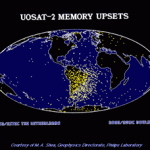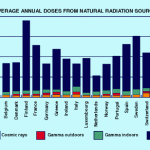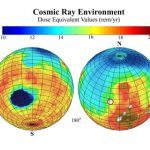Pacemakers can register the effects of severe solar storms, though there is no danger to the patient from the ‘glitches’ that occur.
Modern pacemakers are actually small computers that run sophisticated programs. That means they are subject to radiation-induced, SEUs just like satellite electronics.
Energetic particles reaching the ground can cause pacemaker glitches that are, fortunately, undetectable to the user.
‘They Call Them ‘Satellite Anomalies” – The 23rd Cycle …Even more troubling than satellite electronics is that energetic neutrons produced when solar flare particles strike atoms in the Earth’s atmosphere, can travel all the way to the ground. There they affect aircraft avionics causing temporary glitches in both civilian and military aircraft. About one in ten avionics errors are ‘unconfirmed’ which means that no obvious hardware or software problem could have caused them. One important source of information on these particles is cardiac pacemakers. Millions of these are installed in people, many of whom take trips on jet planes. They record any irregularities in the rate at which they trigger their pulses, and this information can be examined when they return to ground. These errors, among airline staff, do correlate with cosmic ray, and solar activity levels.”
Single Event Upsets in Implantable Cardioverter Defibrillators… “Single event upsets have been observed in implantable cardiac defibrillators. The incidence of SEUs is well modeled by upset rate calculations attributable to the secondary cosmic ray neutron flux…[From 22 upsets recorded over 284672 device-days], This is the first clinical data set obtained indicating the effects of cosmic radiation on implantable devices…Shielding is not practical for cosmic ray secondary neutrons. The relatively low incidence of therapeutic radiation incident on an implantable device and the elimination of incident alpha particles leaves cosmic radiation induced, secondary neutron, single event upsets as the main pervasive ionizing radiation threat to the reliability of implantable devices…Microprocesor based systems in which critical controlling software is in RAM, as opposed to ROM, are especially prone to SEUs. Clearly, an understanding of the soft error rate is vitally important given the high reliability requirements and life-supporting nature of the application.” (Bradley and Normand, 1998 ‘IEEE Transactions on Nuclear Science, vol. 45, p. 2929).
Cosmic radiation comes to ASIC and SOC design … SEEs (single-event effects), such as soft errors, have since the early 1980s appeared in commercial electronics, but they are now becoming the dominant reliability-failure mechanism in modern CMOS technologies. These types of errors forced Sun to recall workstations in the late ’90s and, EDN has learned, also caused failures in memories and ASICs controlling a Cisco router . Experts say that these effects will soon become more commonplace in logic as processes head into 65- and 45-nanometer nodes…Baumann and Paul Dodd, another foremost expert on SEEs and acting manager for the radiation-effects department at Sandia National Laboratories (Albuquerque, NM), says that commercial designs are also more frequently encountering SEEs but that designers are commonly missing or misidentifying them as other failures. “It could be happening on everyone’s PC, but instead everyone curses Microsoft,” says Dodd. “Software bugs probably cause a lot of those blue-screen problems, but you can trace some of them back to radiation effects.” And designers cannot yet quantify the breadth of the problem because, as IC-design and EDA consultant Pallab Chatterjee points out, “It is something companies don’t brag about.”
The subject of SEEs is old hat to designers of radiation-hardened devices and DRAMs and to companies such as International Rectifier, which has for years been SEE-hardening designs for aerospace applications in which radiation exists and reliability is a must (Reference 4). Researchers in the late ’70s observed the problem in terrestrial applications, and it crept in the 1980s into commercial applications running terrestrially. Alpha particles from package materials caused SEEs that first affected DRAM, and, through process refinement, these particles have become less common, but they still account for roughly 30% of all SEEs, Baumann estimates. Thermal neutrons from cosmic radiation of energy less than 15 eV (electron volts) or terrestrial high-energy cosmic particles, such as neutrons, protons, and muons, also cause SEEs (Figure 1). These particles cause reactions with silicon and oxygen nuclei and break them apart, leaving ionizing fragments, which in turn generate a chargenot a desirable effect, according to Baumann.
According to Steve Wender, group leader at the Los Alamos (NM) Neutron Science Center testing facility, placing six inches of steel shield around a device achieves only a twofold improvement in FIT. At least five classes of SEE exist. If any of these effects occurs in a toy or a cell phone, it may be trivial and might not preclude a further purchase, but if they occur in a mission-critical device, such as a pacemaker, a drive-by-wire brake system, or even a handheld device for transferring funds between bank accounts, a three-second glitch can become a catastrophe. (Michael Santarini, Senior Editor — 5/12/2005
EDN )
Soft errors’ impact on system reliability … The rate at which SEUs occur is given as SER, and you measure it in FITs (failures in time), which is the number of failures in 1 billion device-operation hours. A measurement of 1000 FITs corresponds to a MTTF (mean time to failure) of approximately 114 years. The potential impact on typical memory applications illustrates the importance of considering soft errors. A cell phone with one 4-Mbit, low-power memory with an SER of 1000 FITs per megabit will likely have a soft error every 28 years. A high-end router with 10 Gbits of SRAM and an SER of 600 FITs per megabit can experience an error every 170 hours. For a router farm that uses 100 Gbits of memory, a potential networking error interrupting its proper operation could occur every 17 hours. Finally, consider a person on an airplane over the Atlantic at 35,000 ft working on a laptop with 256 Mbytes (2 Gbits) of memory. At this altitude, the SER of 600 FITs per megabit becomes 100,000 FITs per megabit, resulting in a potential error every five hours. The FIT rate of soft errors is more than 10 times the typical FIT rate for a hard reliability failure. Soft errors are not the same concern for cell phones as they can be for systems using a large amount of memory.
High-energy cosmic particles react with the upper atmosphere of the Earth, and their collisions, modulated by solar flares and intergalactic cosmic rays, generate high-energy protons and neutrons. High-energy neutrons have energies of 10 to 800 MeV; in contrast, protons have energies greater than 30 MeV. High-energy neutrons have no charge; therefore, they do not coulombically interact with the semiconductor material, so their interaction with silicon differs from that of an alpha particle. For a high-energy neutron to cause a soft error, it must produce ionized particles by colliding with the silicon nucleus and undergoing impact ionization with the silicon nuclei. This collision can generate alpha particles and other heavier ions, thus producing electron-hole pairs but with higher energies than a typical alpha particle from mold compounds. Neutrons are particularly troublesome, because they can penetrate most manmade construction; for example, a neutron can pass through five feet of concrete. The flux rate is geoposition-dependent and increases at higher altitudes due to a lower shielding effect of the atmosphere. In London, the effect is 1.2 times worse than at the equator. In Denver, with its high altitude, the effect is three times worse than at sea level in San Francisco. In an airplane, the effect can be 100 to 800 times worse than on the ground. (Ritesh Mastipuram and Edwin C Wee, Cypress Semiconductor — EDN, 9/30/2004)
LASERs Simulate Space Radiation Effects … One widely used approach is to employ microelectronic devices that have been specially designed and engineered to be invulnerable to the space radiation environment or, at least, more tolerant of the environment. However, development of such devices is expensive, and their performance (processor speed, for example) generally lags the performance of commercially available nontolerant devices by 10 years or more. A growing body of literature has recently been developed around SEP in the terrestrial environment. The most energetic cosmic rays penetrate the Earth’s magnetic field and interact with nitrogen and oxygen nuclei in the upper atmosphere. These nuclear interactions yield neutrons that can penetrate to the ground. Anyone who uses a solid-state digital camera can observe these events simply by taking extended “exposures” in the dark. Frame-to-frame variations in the output in the form of intense, single-pixel spikes are due to cosmic ray effects. Aircraft designers at Boeing, Airbus, and elsewhere are now taking account of SEP in systems design for aircraft that fly at higher altitudes (above 30,000 feet). Manufacturers of pacemakers for control of heartbeat irregularities worry about SEP effects on the performance of microcontrollers within the pacemaker. Finally, microelectronic device performance may be degraded by SEP due to alpha particle decay from radioactive isotopes of ions that are impurities in metals commonly used for the microelectronics themselves. (Susan Humphrey, Stephen LaLumondiere and Steven Moss, The Aerospace Corporation, Winter-2000 magazine)
Soft errors caused by single event upsets in CMOS processes
” Radiation-induced single event upsets (SEUs) pose a major challenge for the design of memories and logic circuits in high-performance microprocessors in technologies beyond 90 nanometers. Historically, we have considered power-performance-area trade offs. There is a need to include the soft error rate (SER) as another design parameter. In this paper, we present radiation particle interactions with silicon, charge collection effects, soft errors, and their effect on VLSI circuits. We also discuss the impact of SEUs on system reliability. We describe an accelerated measurement of SERs using a high-intensity neutron beam, the characterization of SERs in sequential logic cells, and technology scaling trends. Finally, some directions for future research are given….In 1996, a survey of computer log files showed that a supercomputer with 156 Gbit of DRAM could fail several times per day, and the incidence of soft errors in implanted pacemakers was about the same as if the errors were caused by background neutron radiation…” (Karnik, T.; Hazucha, P. in IEEE Transactions on Dependable and Secure Computing, Vol. 1, Issue 2, April-June 2004, pp.128 – 143)
More From SolarStorms.org:
Submit your review | |







